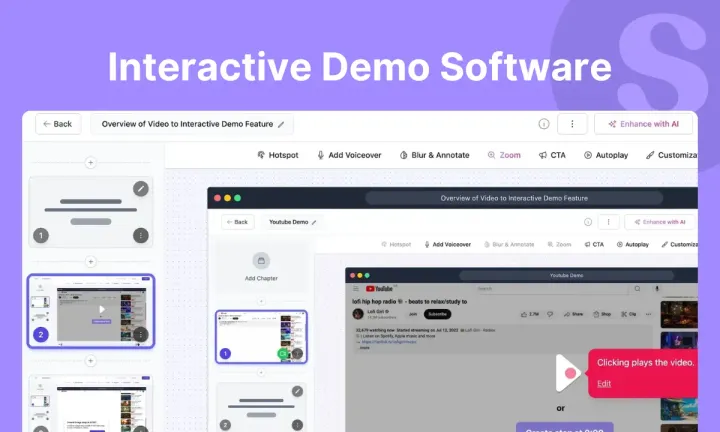In today's rapidly evolving technological landscape, businesses are constantly seeking ways to engage and convert potential customers. One powerful tool that has gained significant traction is the use of interactive demos. These demos serve as a bridge between a product's features and a customer's needs, offering a firsthand experience of its capabilities. However, simply creating a demo software is not enough; the key lies in harnessing data-driven insights to optimize and continually improve the demo experience. In this blog, we'll explore the concept of the data-driven demo and how leveraging analytics can drive continuous enhancement.
Interactive Demos: A Gateway to Engagement
In the ever-evolving realm of business presentation, the advent of interactive demos has sparked a transformative shift. These dynamic showcases have ushered out the era of static presentations and uniform demonstrations. Unlike the one-size-fits-all approach, interactive demos empower potential customers with the freedom to delve into a product's attributes on their terms. Through seamless interactions within a simulated environment, individuals can authentically engage with different facets of the offering.
This experiential journey provides a unique opportunity to envisage the product's integration into their personal workflows or lifestyles. As a result, not only does this immersive encounter amplify engagement levels, but it also fosters a deeper comprehension of the product's value proposition. The interactive demo thus serves as a pivotal bridge between businesses and customers, forging a lasting connection built on understanding and exploration.
The Role of Data-Driven Demos
The concept of a data-driven demo transcends the superficial layers of aesthetics and technological allure. It encompasses a strategic approach that delves into the core of user engagement. Beyond the allure of a visually pleasing user interface and the integration of cutting-edge technology, a data-driven demo revolves around a meticulous design that acts as a perceptive observer of user interactions and behaviors.
This dynamic approach involves the systematic collection and thoughtful analysis of data derived from user engagements. Through this process, businesses can unearth invaluable insights into the intricate dance between users and the demo. These insights unveil the nuanced patterns of how users navigate the demo, shed light on which features hold the strongest allure, and highlight potential hurdles that may hinder the seamless journey.
By gaining this profound understanding, businesses are equipped with the tools to sculpt a demo that resonates profoundly with its audience. Armed with empirical evidence, they can fine-tune the demo's elements, enhancing the prominence of features that draw the most interest and strategizing solutions to alleviate potential obstacles.
In essence, a data-driven demo is the embodiment of strategic foresight, where every interaction becomes a puzzle piece contributing to a larger, more insightful picture. It empowers businesses to craft an experience that aligns harmoniously with user preferences, thus fostering a deeper connection and propelling the journey of engagement to new heights.
Analytics for Improvement: From Insights to Action
The true power of a data-driven demo lies in its ability to provide actionable insights. Analytics enable businesses to uncover patterns and trends that might have otherwise gone unnoticed. For instance, metrics such as click-through rates, time spent on different features, and drop-off points can paint a comprehensive picture of user engagement.
Armed with these insights, businesses can make informed decisions about demo optimization. Perhaps certain features are underutilized, and their prominence could be enhanced. Alternatively, identifying pain points or confusion areas within the demo can lead to targeted improvements that address user concerns.
Measuring Demo Success
Metrics play a vital role in measuring the success of a data-driven demo. Conversion rates, user satisfaction scores, and even post-demo engagement can serve as benchmarks for evaluating the demo's impact. By comparing these metrics over time, businesses can gauge the effectiveness of their demo optimization efforts.
Leveraging Data Insights: A Continuous Cycle of Enhancement
The path to an optimized demo is a dynamic voyage, far from a single event but rather an ongoing, iterative evolution. This journey of refinement involves a perpetual commitment to progress. By harnessing the power of data insights, businesses can navigate this journey with precision. The data serves as a compass, illuminating bottlenecks or untapped opportunities. Informed by genuine user interactions, incremental adjustments take shape, each change strategically aligned to address real-time needs.
This orchestrated dance of adaptation culminates in a demo that harmonizes seamlessly with the preferences and desires of the intended audience. Through this continuous process of enhancement, the demo becomes a living entity, fluidly adapting to the evolving landscape of user engagement and ensuring a resonance that captivates and delights.
Conclusion
In the rapidly evolving realm of technology-driven business, the quest for engaging and converting potential customers is ceaseless. Enter the interactive demo, a powerful tool that bridges product features with customer needs, providing firsthand glimpses of capabilities. Yet, creating mere demo software falls short; the true power lies in data-driven insights that optimize and evolve the demo experience. This article has delved into the concept of the data-driven demo, unveiling its potency through leveraging analytics.
From the transformative realm of interactive demos to the strategic depth of data-driven design, the journey unraveled the intricate tapestry of user engagement. This process isn't stagnant; it's an ongoing evolution, fueled by insights that identify growth avenues and user hurdles. These insights crystallize into tailored improvements, creating demos that resonate deeply with audiences.
Analytics transform data into action, unveiling hidden patterns and refining features. Metrics offer a yardstick for success, and data insights foster an iterative cycle of enhancement. In this synergy between data and design, the demo emerges as a fluid entity, perpetually adapting to users' shifting needs.
Ultimately, the data-driven demo is a testament to innovation's marriage with customer understanding – a journey of evolution ensuring a vibrant, resonant connection between businesses and their audiences.



